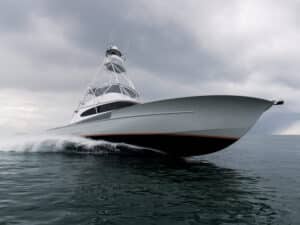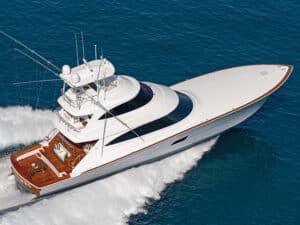
Amazingly, the White Lightning 61 was built through the efforts of just two men – Roy Barnes and Bill Schwabe. Despite the lack of a full or even skeleton crew, this 61-footer still carries on the tradition of very capable Carolina boats.
Probably the best feature of the 61’s performance is its fuel economy. It boasts much smaller engines than you’d expect to find in a 61-footer. However, its twin 900-hp diesels cruise comfortably at 30 knots while burning less than 60 gph. Top speed touches 36.5 knots, still highly respectable.
With Synchro turned on, it takes about 13 seconds to plane or about a second less than with it turned off. Once you’ve reached cruising speed, this 61 can make a U-turn in about three boat lengths with a loss of about 3 knots.
The White Lightning 61 has been designed and built by avid offshore fishermen. So even though you might choose to do things differently, the 225-square-foot cockpit has been masterfully laid out for fishing with a large tackle center, several iceboxes, in-transom livewell/fish box, 22 rod holders (with more on the flybridge) and three fighting chairs. You’ll also appreciate the superb gaff storage, as well as freshwater and saltwater washdowns.
The rails all hit you at mid-thigh, you can easily fish six anglers at once without touching shoulders, and the extra-large overhang on the forward end will keep everyone in the shade while awaiting those multiple hookups.
White Lightning has located the fuel fills under the cockpit’s salon step. An unusual placement, to be sure, but you certainly won’t ever worry about fuel overflowing into the harbor from there. A narrow hatch on centerline provides engine access through the cockpit, but the owners more often use a hatch in the galley. I found both to be very tight squeezes.
You won’t find a more straightforward flybridge layout than the White Lightning’s. In addition to a single helm seat, straight settees to port and starboard line the sides, leaving a large open space forward of the console.
A comma-shaped helm console with flip-up Lucite covers leaves all instrumentation within easy reach, though I would prefer to see the covers recess into the console as they block viewing from certain angles when left open. And as befits a well-planned offshore boat, you’ll find excellent handholds everywhere aboard, including the bridge.
Inside, I like almost everything about the galley, from its Corian-like counters with a cooktop to its Jenn-Aire grill. The forward cabin holds a queen-sized berth set in the cabin obliquely. The amount of space in the cabin surprised me. Most Carolina boats have very small forepeak cabins, thanks to the superfine entry and significant bow flare that make them such fabulous head-sea boats. This 61 doesn’t seem to suffer from the narrowness nearly as much.
Holding on to its charter-boat roots, the White Lightning 61 sports a very nice day berth to starboard at the foot of the stairs and has a large deep freeze beneath one end with the washer/dryer under the forward end. Another large twin berth and head lay to port. All berths lift up on hydraulics for access to huge storage areas.
As with most Carolina boats, the White Lightning is very handsome. All above-deck bulkheads are Tri-Cell cored with light, pickled red oak veneers, while belowdecks all structural bulkheads are Divinycell cored. The bottom consists of three layers of 3/8-inch fir plywood, while the topsides get three layers of 1/4-inch plywood with the outer player being Okume. The inside and the outside of the hull get glassed with biaxial cloth.
To keep things in the living quarters quieter, White Lightning has located a separate room on the forward end of the engine room for pumps, icemakers, air-conditioning compressors, water makers and the like. Logically, then, the generator sits at the aft bulkhead.
My favorite feature has to be the exceptionally handsome tackle storage locker. Racks for hanging lures and multiple-layer welded rod racks make this one of the best designs I’ve seen. The only change I might make is to dress it up more. After all, heavy tackle outfits are nearly works of art.







